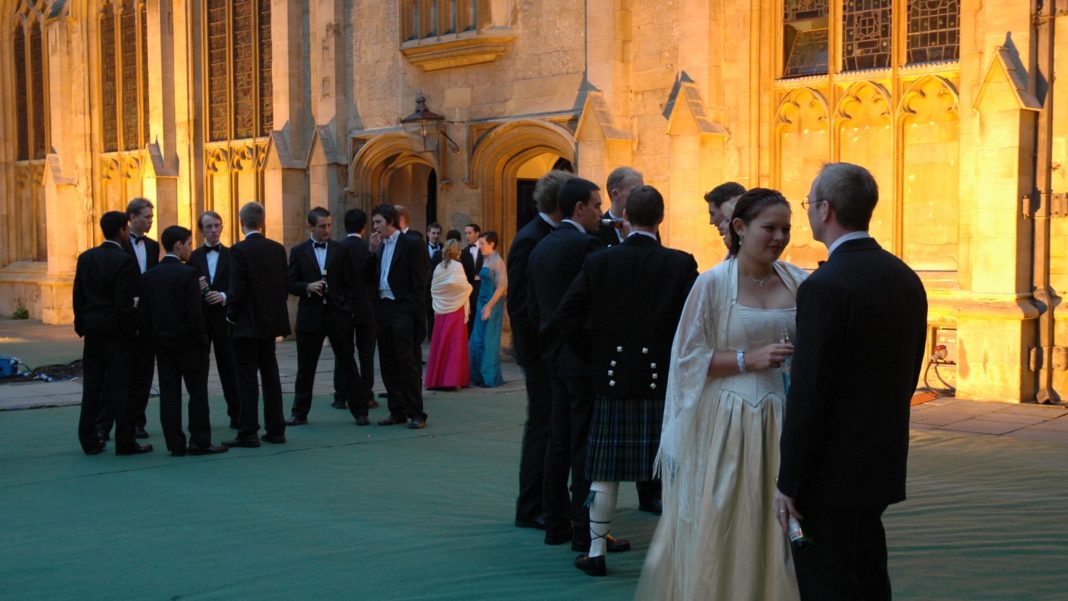A couple days after attending Brasenose Ball with my friends, I received a surprise notification from a group chat that I had suspected would now lie dormant and untouched. I had assumed that the group chat, used to coordinate plans for the ball and upload photos, would fade into obscurity – a remnant of an unforgettable night now immortalised in both my memory and camera roll. Instead, two days later, a single, unexpected photo appeared on the chat. It came accompanied by a brief message: “You made it to the Daily Mail”.
The photo itself isn’t bad; it’s quite a good photo, in fact, and more flattering than some others in the article. Just after the ball’s denouement at 5am, in a concoction of drunken bliss and delirium as dawn crept in, I took a few photos of a couple of my friends outside of the Rad Cam, seizing the priceless moment of a library devoid of tourists while light suffused over the building. Moments before this, I remember seeing a man with a professional camera, lingering expectantly, but I had merely passed him off as inconsequential, assuming he was a ball photographer.
With the group chat now resurrected, reaction varied considerably: amusement towards the notion of us getting papped; immense relief that it was one of the kinder photos that had been featured; skepticism towards whether he had asked us for consent to take the photos and let them be published. (Our somewhat hazy recollections left us confused as to whether he had asked.)
The article itself wasn’t entirely Oxford-centric, instead exploring the various ways that people throughout the UK had spent the bank holiday weekend in Blackpool, Birmingham and Leeds. Nevertheless, subtext wasn’t exactly required to understand the chasm that the writer was emphasising between the “casual looking groups of partygoers eating greasy late-night snacks” elsewhere and the “revellers in Oxford […] making their way home from prestigious balls”. Everything from attire to food was contrasted, depicting Oxford as a swaggering social hub, reminiscent of glittering, Gatsby-esque party scenes in stark contrast to the more raucous and conventional celebrations of pub crawls and clubbing at other locations. This sort of divide was reinforced by the article’s comment section, who seemed eager to stress the “dash of elegance” that tinged Oxford’s events compared to the “kebab noshing on the streets” of Birmingham (when they weren’t making vulgar observations about body types and sizes).
Media depictions like this, setting Oxford at odds with other universities, reinforce stereotypes of Oxford that vastly exaggerate the reality of things. Whilst I’m not denying that going to Oxford offers privileged opportunities, other universities also hold their own black-tie events with similar attire and entertainment. Oxford students are still students and so, for the most part, clubbing, pub crawls and other less sophisticated forms of entertainment remain staples of their university life. We regularly flock to Hussain’s in ritualistic fashion after a night spent at Atik – not the most glam venue in the world.
The media’s narrative that pedestalises Oxford and solely associates it with poshness and prestige is a caricature of the typical experience. It unjustly represents the majority of students who don’t align with these archetypes and broader media depictions surrounding Oxford have only fuelled this fire. Movies such as Saltburn, released in 2023 (and which is set at Brasenose College), have contributed to these unrealistic depictions of Oxford life. Fictional elements from the film may contain kernels of realism, but for the greater part are exaggerated and embellished in order to enhance the plot and drama of the movie. ‘Murder on the Dancefloor’ being played at least ten times across the night further attests to this sensationalised vision of Oxford. The media feeds on confining Oxford to this state of unwavering poshness, tying its tradition, reputation and history together to characterise rare occasions like these as routine hallmarks of Oxford life. By doing so, it fails to recognise that most of the students here, are in actual fact, not that dissimilar from those elsewhere.
This isn’t to say that glaring issues shouldn’t be exposed and rectified; Pembroke ball tickets costing nearly £450 means that the ball is inaccessible for the vast majority of students. Exorbitant prices like these alienate students and generate justified outcry, whilst propagating preconceptions of Oxford’s poshness and elitism. Elitist societies of the past, such as the Bullingdon Club, warranted strong condemnation for their discrimination and reprehensible behaviour. However, the media’s current narrative that isolates Oxford students from typical student life by painting them all with the same brush is an inaccurate portrayal of the real Oxford experience for most, where balls and secret societies are few and far between in the academic calendar.
While others may be cringing at the state of some of the less generous photos, I find it amusing how a relatively unremarkable picture of a student taking photos of their friends constitutes the attention of national news. The Daily Mail making a spectacle out of normal students ironises the whole matter really; at the end of the day, at least I know that my own photography skills are clearly worthy of national fascination.


